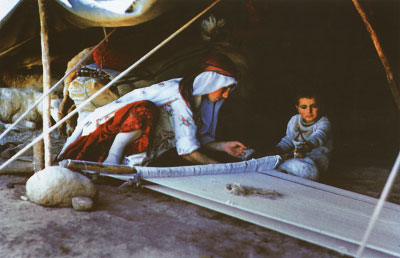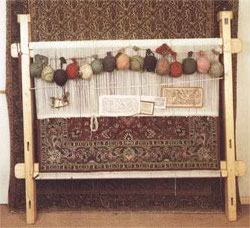
Weaving looms vary considerably in size and sophstication but the basic principals remain unchanged. A secure frame is required to which the wrap stands are tied, it is either fixed or adjustable
On adjustable looms, the vertical beams are fixed but one or both of the horizontal beams that hold the warp strands in place can be moved up or down the frame.
The loom is a crucial factor in the structural quality of the carpet
The carpets are generally divided into two types: Horizontal looms(flat): and vertical looms (upright)
Horizontal looms
As the name suggest these are used exclusively by nomad weavers. The fact that the loom is horizontal means the weavers have to do much of their weaving from the sides, which becomes very difficult if the rug is too wide. Thus the nomadic rugs tend to be small, narrow and long. Despite the limitation of the nomadic loom. It is perfectly suited to the nomad's way of life, being easy to assemble and take down, and not too large or too heavy to be carries by donkey or mule

Vertical looms
These looms can only used in cities and villages. The structure of these,
to some extent, is more complicated than that of the horizontal ones.

The design and the measurement of the carpets woven on these looms are more precise than those woven on horizontal looms.
The different forms of the vertical looms are as follows: One kind has the shape of a frame and is composed of two wooden horizontal beams joined from both upper and lower sides and two other beams connected vertically which run across the horizontal beams.
The warp is stretched between the two horizontal beams. The village loom, which is rather more upright than horizontal, is almost primitive and resembles the nomad loom a lot. The weaver sits on a plank facing the loom and as the weaving advances, the plank is gradually rasided higher.
In this kind of loom, the length of the carpet is usually shorter than the length of the loom.
TECHNIQUES AND WEAVING PROCESSES
In all the main carpet weaving centres of Iran, the fundamentals of carpets weaving are the same. The warp and the weft are often referred to as "Foundation". The warps are the strands of the material that run length ways from top to the bottom of the rug and form fringes at the ends. The weft runs width wise. Normally both the warp and the weft are made from cotton material and white colour but some nomads such as Ghashghai, Baluchi, Lori, Bakhtiari, etc. Use wool as a foundation. In the early stages of carpet weaving, the first two centimetres (maximum 4 cm.) were woven as ordinary textile and in Persian terminology was called "Gilim-baft". After this phase the basic part of carpet weaving begins. According to the design selected, the fibres that could be the wool, silk or cotton and composed of coloured and numbered skeins are laid adjacent or hung from the pile. After the first row of knotting is executed every other line , one or two weft threads are passed through the warps. As a hook has separated the warps from each other, it is therefore easier to pass the weft through the warps. The function of the weft is to press together and firmly unite the knotted parts to the body of the carpet. The knots are combed downwards by means of a special metal comb, to press the knots into the carpet.

Most of the Persian carpets are usually two wefted and the tribal carpets are one wefted.
After weaving a few rows, the senior artisan carefully cuts the head fringes with special scissors. When the knotting of the carpet is completed , again a few centimetres of the carpet are woven as "Gilim-baft" as was done at the beginning. Then the wraps are cut just a little. Following this, the carpet is laid on the ground or on a flat cylinder were the sufface is sheared and somoothed. Machines do the sharing at some of the modern weaving centres of Tehran and Kerman.
The height of the pile, the width of the selvage, number of wefts, length of the fringes, etc is variable depending upon the local sustom and traditions.After some wear the pile of the carpet gets gradually reduced, leading to a better view of the carpet design and pattern. Consequently the high - pile carpets are woven by tribesmen.